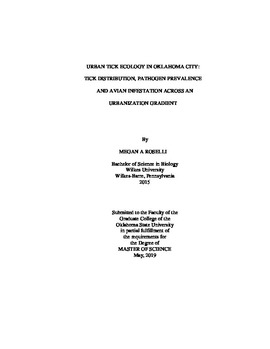| dc.description.abstract | Urbanization has been linked to the emergence and increased prevalence of many vector-borne diseases, including tick-borne diseases. Despite the growing public health importance of tick-borne diseases, little is known about how they are influenced by urbanization in North America, especially in the central U.S. where several pathogens occur at or near their highest levels of incidence nationally. To understand how urbanization effects tick-borne disease, we investigated tick distribution, tick-bone pathogen prevalence, and tick-host interactions across a gradient of urbanization in Oklahoma City, Oklahoma, USA. At 16 parks and greenspaces we collected ticks using CO2 traps and flagging, measured temperature and humidity during tick sampling, conducted vegetation surveys, and used trail cameras to estimate an index of deer abundance. Adult ticks were tested for Rickettsia sp., Ehrlichia sp., Anaplasma sp., Borrelia sp., and Francisella tularensis. Additionally, we mist-netted birds during the breeding season, sampled them for ticks. Our results indicate there is a risk of encountering ticks and pathogens across the entire urbanization gradient from exurban areas to the urban core, although some tick species and pathogens (Dermacentor variabilis and Ehrlichia ewingii) may be less common in intensely urbanized areas. We also found that vegetation, temperature, and moisture variables predict tick abundance and that these correlates vary among species. The index of deer abundance was positively correlated with A. maculatum and D. variabilis abundance but unrelated to A. americanum abundance, but urbanization intensity did not influence either the proportion of birds with ticks or the tick load of infested birds. Our results suggest that urban residents are at risk for encountering a tick-borne disease, and it's unlikely that deer by themselves are driving tick abundance in Oklahoma City since such a large proportion of birds were infested with ticks. Public health officials and land managers can use such information about parks and their surroundings to focus public education and land management efforts designed to reduce tick-borne disease prevalence. | |
